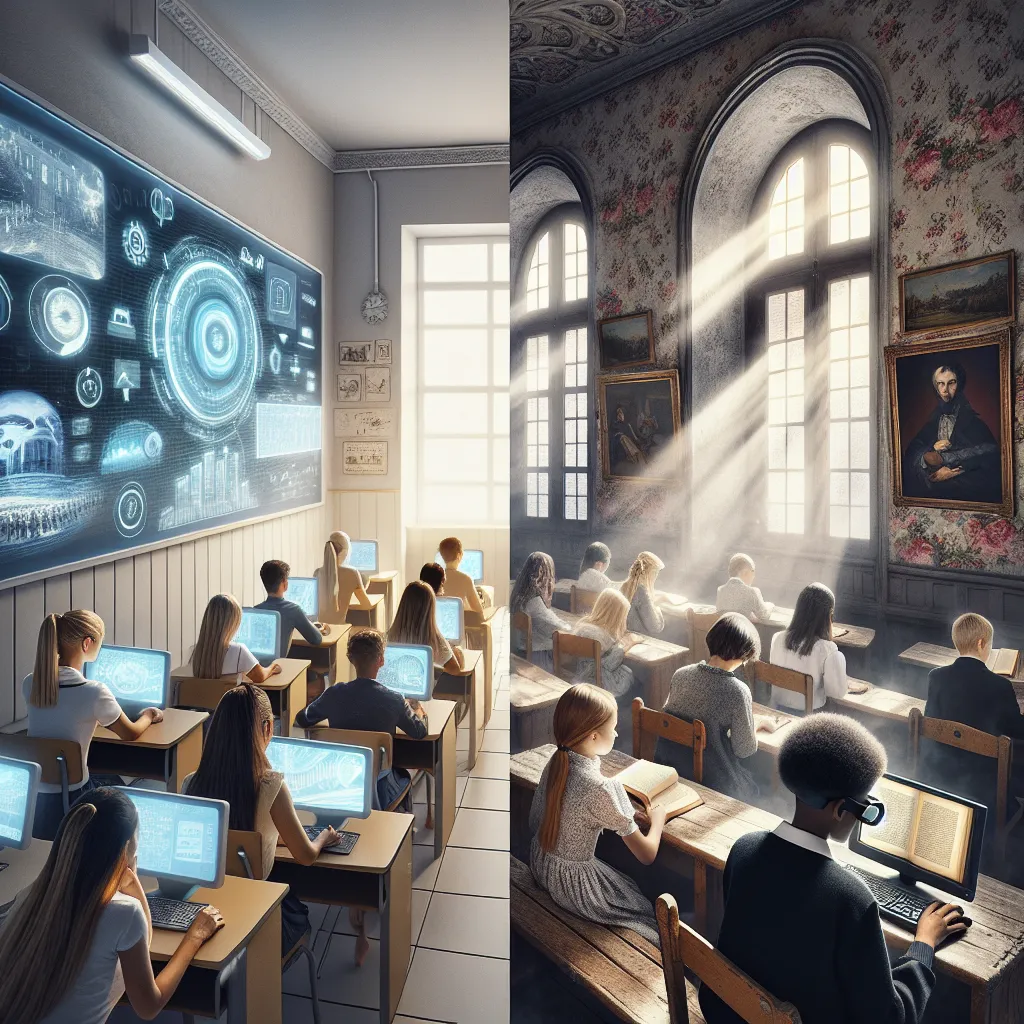The IELTS Reading section is a crucial component of the test, assessing your ability to comprehend complex texts and respond to various question types. Today, we’ll focus on a topic that has gained significant attention in recent years: “The Impact of the Digital Divide on Education.” This subject has appeared in several past IELTS exams and, given its ongoing relevance in our increasingly digital world, it’s likely to resurface in future tests. Let’s dive into a practice passage and questions to help you prepare for this potential topic.
 Digital divide impact on education
Digital divide impact on education
Reading Passage
The Digital Divide in Education: Bridging the Gap
The term “digital divide” refers to the gap between those who have access to modern information and communication technology (ICT) and those who do not. In the context of education, this divide has become increasingly significant, particularly as digital tools and online resources have become integral to learning processes worldwide.
The impact of the digital divide on education is multifaceted and far-reaching. In developed countries, students often have access to high-speed internet, personal computers, and a wealth of online educational resources. This access allows them to engage in interactive learning experiences, conduct research efficiently, and develop crucial digital literacy skills. Conversely, students in less developed regions or from lower socioeconomic backgrounds may lack these resources, potentially putting them at a significant disadvantage.
One of the most apparent consequences of this divide is the disparity in access to information. The internet has become a vast repository of knowledge, offering instant access to a wide range of educational materials. Students with reliable internet access can tap into this wealth of information, supplementing their formal education with additional resources, online courses, and educational videos. Those without such access are limited to traditional textbooks and whatever resources their schools can provide, which may be outdated or insufficient.
The COVID-19 pandemic has further highlighted and exacerbated this divide. As schools worldwide shifted to online learning, students without access to devices or reliable internet connections found themselves unable to participate fully in their education. This situation has raised concerns about widening achievement gaps and long-term educational inequalities.
Moreover, the digital divide affects more than just access to information; it also impacts the development of critical skills. In today’s digital economy, proficiency in using technology is increasingly important for future career prospects. Students who lack exposure to digital tools may find themselves at a disadvantage when entering the workforce or pursuing higher education.
Efforts to bridge the digital divide in education are ongoing globally. Governments and non-profit organizations are implementing initiatives to provide technology and internet access to underserved communities. Some programs focus on distributing devices to students, while others work on improving internet infrastructure in rural or low-income areas.
However, addressing the digital divide is not solely about providing hardware and internet connections. It also involves ensuring that teachers are adequately trained to integrate technology into their teaching methods effectively. Additionally, there’s a need for developing high-quality digital content that is accessible and relevant to diverse student populations.
As we move further into the 21st century, bridging the digital divide in education remains a critical challenge. It’s not just about ensuring equal access to technology, but about creating equal opportunities for all students to develop the skills and knowledge necessary for success in an increasingly digital world. The way we address this challenge will have profound implications for educational equity and social mobility in the years to come.
Questions
True/False/Not Given
Determine whether the following statements are True, False, or Not Given based on the information in the passage.
- The digital divide refers only to the gap in internet access between different countries.
- Students with access to digital resources can engage in more interactive learning experiences.
- The COVID-19 pandemic has increased awareness of the digital divide in education.
- All efforts to bridge the digital divide focus solely on providing hardware to students.
- Teacher training is an important aspect of addressing the digital divide.
Multiple Choice
Choose the correct letter, A, B, C, or D.
-
According to the passage, which of the following is a consequence of the digital divide in education?
A) Increased enrollment in online courses
B) Higher dropout rates in rural schools
C) Potential disadvantages in future career prospects
D) Improved digital literacy skills for all students -
The passage suggests that addressing the digital divide requires:
A) Only providing internet access to all students
B) Focusing exclusively on developed countries
C) A multifaceted approach including infrastructure and training
D) Eliminating traditional textbooks from schools
Matching Headings
Match the following headings to the correct paragraphs in the passage. Write the correct number (i-vii) next to questions 8-10.
i. The role of governments in tackling the divide
ii. Defining the digital divide
iii. Long-term implications of the digital divide
iv. The pandemic’s effect on educational inequalities
v. Skills development and future opportunities
vi. Initiatives to provide technological access
vii. The importance of information access in education
- Paragraph 2 ____
- Paragraph 4 ____
- Paragraph 5 ____
Answer Key and Explanations
-
False
Explanation: The passage states that the digital divide refers to the gap between those who have access to modern ICT and those who do not, not just between countries. -
True
Explanation: The passage mentions that students with access to digital resources can “engage in interactive learning experiences.” -
True
Explanation: The passage states, “The COVID-19 pandemic has further highlighted and exacerbated this divide.” -
False
Explanation: The passage mentions various efforts, including “providing technology and internet access” and “improving internet infrastructure,” not just hardware provision. -
True
Explanation: The passage states, “It also involves ensuring that teachers are adequately trained to integrate technology into their teaching methods effectively.” -
C
Explanation: The passage mentions that students without digital skills “may find themselves at a disadvantage when entering the workforce or pursuing higher education.” -
C
Explanation: The passage suggests a multifaceted approach, including infrastructure, device distribution, teacher training, and developing digital content. -
ii
Explanation: The second paragraph begins by defining and explaining the concept of the digital divide in the context of education. -
iv
Explanation: This paragraph discusses how the COVID-19 pandemic has highlighted and worsened the digital divide in education. -
v
Explanation: This paragraph focuses on how the digital divide affects the development of critical skills necessary for future career prospects.
Common Mistakes to Avoid
-
Overlooking subtle details: In True/False/Not Given questions, pay close attention to specific wording. For example, statement 1 uses the word “only,” which makes it false based on the broader definition given in the passage.
-
Making assumptions: Avoid drawing conclusions not explicitly stated in the text. For Multiple Choice questions, ensure your answer is directly supported by the passage.
-
Misinterpreting Matching Headings: Focus on the main idea of each paragraph rather than specific details when matching headings.
Vocabulary Focus
- Digital divide: The gap between those with access to modern information and communication technology and those without.
- Multifaceted: Having many different aspects or features.
- Exacerbate: To make a problem or bad situation worse.
- Disparity: A great difference between things or people.
- Proficiency: A high degree of skill or expertise.
Grammar Spotlight
Pay attention to the use of conditional sentences in the passage, such as:
“Students who lack exposure to digital tools may find themselves at a disadvantage when entering the workforce or pursuing higher education.”
This is an example of a first conditional sentence, used to express a real possibility in the future. The structure is: If/When + present simple, will/may/could + infinitive.
Tips for IELTS Reading Success
-
Practice active reading: Engage with the text by highlighting key points and making mental summaries as you read.
-
Improve your time management: Allocate your time wisely between reading the passage and answering questions.
-
Expand your vocabulary: Regularly learn new words and phrases related to technology and education to prepare for passages on these topics.
-
Familiarize yourself with all question types: Practice with various question formats to improve your speed and accuracy.
-
Read widely: Expose yourself to a variety of texts on different subjects to improve your overall reading comprehension.
By focusing on these strategies and practicing regularly with passages like this one, you can improve your performance in the IELTS Reading section. Remember, understanding the impact of the digital divide on education is not only crucial for your IELTS success but also for your awareness of important global issues.
For more practice on related topics, check out our articles on the impact of online learning on traditional education and the role of the internet in modern education. These resources will help you further expand your knowledge and vocabulary in this important area.


